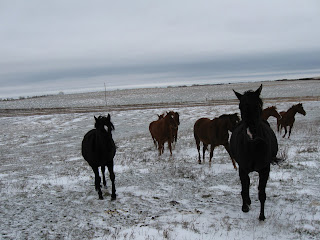Company left this morning, and have all arrived safely back home to parts distant -
and hopefully drier! The weather remains rotten. Old Man Winter & Mother Nature fought over turning us into a snow globe or a skating rink all day. Freezing rain, fog, stingy little snowflakes.... Everything is just warm enough to be mud, and just cold enough to be slippery.
The drive to the farm was... interesting. The road was greasy enough to require 4 wheel drive. Not enough weight in the back of the truck.
Note to self: must find something heavy to ride back there!
Sunny & co were contentedly working their way into a new round bale when I got there.
Thank you, G! I spread what remained of the last bale between feeding stations, allowing all of them a chance at some groceries.
 Sunny guards his spot
Sunny guards his spotSunny is a dog in the manger with food. He eats first, and gets the best spot, always. In the picture above, he's simultaneously dozing and guarding his spot at the hay feeder by standing with his butt to the rail so none of the others can have it.
When he's eating the two three-year-olds are tolerated next to him, and he'll share with them - even grain, most times - so they tag along behind wherever he goes, taking the spots to right & left like good little henchmen. Thunder, the only other gelding in the group, is definitely low horse, and the mares remove him if he's in the way. So he uses Sunny like a shield to get away from the mares. Amyra on the other hand, uses Sunny's presence like a club, bullying the other mares and then scooting back behind him when they retaliate. Minx!
If Sunny feels the mares are encroaching or their hay is better than what he has, he dispossesses them. Usually with no more than a threatening look - pinned ears or a snaked neck, but he's not shy about backing it up with bites & heels if they're laggard about moving. They sidle behind him warily to get at the other end of the feeder, and if forced to eat to close by, they keep a weather eye on him, ready to move if he shifts in their direction.
Ideally, he'd be separated out or be in with only one or two others, but logistically to access the waterers, the horses need to be in together. They can't go in with the sheep (
those fences are not horse safe!), and G doesn't want them in with the cows, either. So....
There's enough access to hay for all of them to get to a spot, and moving around does keep them active. Sigh.
Someday I WILL have my OWN place to keep my horses and be able to manage them as I please.
 One escaped sheep
One escaped sheepAnd where there's one, there will likely be more soon. Escapees invariably multilpy like rabbits! I couldn't determine where this one had escaped from, though. All the gates & panels were up as far as I could tell, so I left it be rather than risking both our limbs in the mud & ice trying to chase it back into what would proabably be the wrong lot. It won't stray far from the flock and ready access to hay.
 . I finally had the chance to check it out in person in Barnes & Noble a couple of weeks ago. All I can say is, Wow!
. I finally had the chance to check it out in person in Barnes & Noble a couple of weeks ago. All I can say is, Wow!
























